Change Your Smile in 2019

Millions are ready to make changes in their life with the start of a new year. If you haven’t already, consider adding resolutions to transform your smile in 2019. This is quite easy to do if you have the right tips to get started. Whether you want a whiter smile, straighter smile or you want to change your oral health issues, you can achieve it.
Resolutions 2019
Making New Year’s resolutions is something that countless millions will do in the month of December. For many, the start of a new year is a time for reevaluating health and life goals, and a time when many recommit to goals they didn’t quite reach. Some of the top resolutions include:
- Eating healthier
- Exercising more
- Smiling more
- Saving money
- Making better health choices
- Sleeping enough
- Being social
Did you notice that oral health isn’t anywhere on the top resolutions that people make? Oral health is often overlooked because it seems like something so small compared to your overall health. However, your oral health is directly related to how healthy you are. Improvements to your smile and mouth health can improve your health and wellness.
Many chronic conditions become worse if your oral hygiene is lacking. Some include diabetes, heart disease, autoimmune disorders, and anything that has to due with your nutrition. With chronic oral health problems such as extensive tooth loss, your overall health will decline rapidly. You may not be able to eat, and chewing, biting, smiling and other basic functions will become difficult. However, most oral health issues are avoidable by simple habits done daily. You have heard of most of these habits already, as they are the basics you hear from the dentist every time you go in for a visit. However, most people can improve their technique with oral hygiene even if they are already doing the basics.

Small Changes, Big Results
Our patients either have braces on their teeth or they are looking to get them. Great oral health is needed if you want to get braces on your teeth. We make sure that our patients are free of cavities and gum issues before orthodontic treatment happens. That means, a dental visit is needed to check for any dental issues beforehand. When dental issues are there, they are fixed and great oral hygiene must be followed thereafter. That includes:
- Brushing. Brush your teeth at least twice a day with fluoride toothpaste. With braces, brush after every meal. Use a proxabrush tool or a Waterpik to dislodge stuck food. Brush in all different directions, especially with the brackets. Replace your toothbrush every 3 months or when the bristles become frayed.
- Flossing. This step is skipped often, but is so important to your smile! Flossing gets 40% of your tooth surfaces. If you want a better smile with braces, you gotta floss or that smile will be damaged. Whether you have braces or are getting them, make the decision to floss 1-2 times every day, using floss threaders or threadable floss.
- Nutrition: Skip the sugary foods as much as possible. This leads to plaque production and tooth decay. Avoid carbonated drinks or ones with citrus that leads to tooth erosion.
Continuous Oral Problems
If you brush, floss, visit the dentist and use oral health aids like mouthwash and fluoride, you may wonder why you still get cavities and gum problems. Studies show that your smile and oral health can be determined by genetics in some cases. Some genes that run in families or specific cultures can make you more susceptible to oral health diseases. For example, those of African descent have specific genes that make them more susceptible to gum disease.
If you have specific conditions that run in your family such as heart disease or diabetes, oral health problems will likely follow suit. This is not inevitable, but something you must be aware of. If you have any sort of chronic condition, make sure you are doing all that you can to have good oral hygiene habits throughout your day. If you continue to have frequent oral problems or issues with your smile, we can go over proper oral hygiene methods during one of your orthodontic appointments. Great oral hygiene and following proper techniques is very important to keeping your teeth healthy and strong, especially with braces. Sometimes, all it takes is changing up your technique or what you are eating to have better oral health and a better smile.
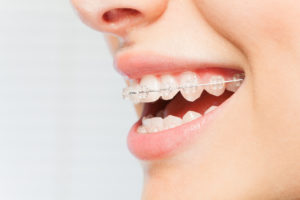
Cosmetic Changes to Your Smile
If you want to completely transform your smile in 2019, don’t wait to get orthodontic treatment. Studies show that getting braces is a great way to not only help you reduce your oral health problems, but an excellent way to get a better smile. Orthodontic treatment generally takes 18 months or less from start to finish. Some patients only need braces for 6 months depending on their teeth and what treatment option they choose.
There are many orthodontic options patients have to transform their smile, and half of them are invisible options. That means, you can’t see the appliances on your teeth. You have the options of:
- Traditional Metal Braces – These are the classic metal bracket and wire option that is most commonly chosen by patients.
- Ceramic Braces – These have the same bracket and wire design of metal braces, except that they are made out of white ceramic material. This helps decrease demineralization during your orthodontic treatment.
- Lingual Braces – This is a discrete metal braces option that is placed on the back of your teeth. Instead of just a square bracket, the metal must be custom-made to the shape of the back of your teeth.
- Invisalign Treatment – This is the most invisible option available to our patients. Invisalign is a series of transparent aligners that you wear at night and throughout the day. You can remove them for eating, playing sports, cleaning your teeth and more.
To choose your option today, call Belmar Orthodontics at (303) 225-9016!
Why You Need Both a Dentist and Orthodontist
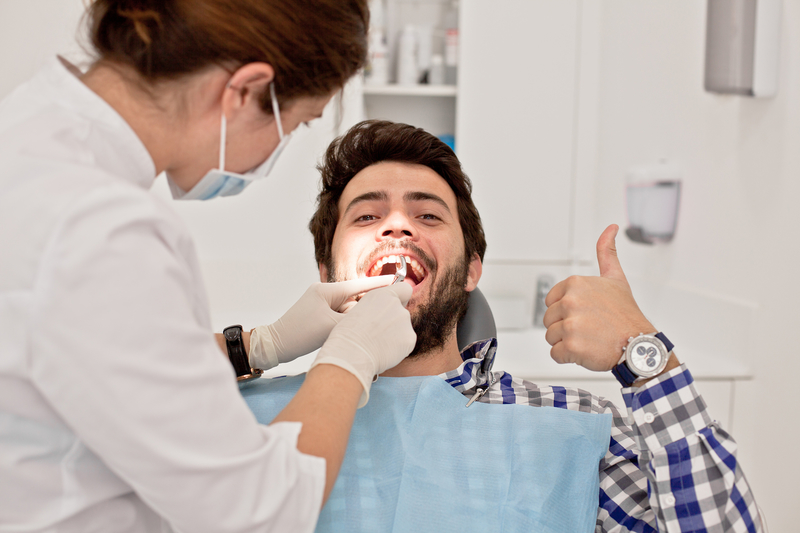
Dentists and orthodontists are both highly-trained professionals that can transform your smile. However, they provide completely different services to patients and both may be needed to help get your smile as healthy as possible. Orthodontic treatment connects to dentistry in many ways, as do the professionals themselves. If you’re like many others, you may need both professionals to keep your oral health in check.
Your Oral Care
Did you know that your oral health can affect all other aspects of your health? This is especially true if you already have some chronic conditions such as diabetes and heart disease. If your oral health isn’t taken care of, your overall health can worse and you are more susceptible to infection. If you don’t control chronic conditions, your oral health can worsen, as the blood vessels that nourish your teeth and gums can become damaged. Your teeth are more likely to decay and get infections that lead to tooth loss.
That is why taking care of your oral health is so important. It can help determine the state of your overall health and if you keep your teeth for a few years or for many. Many people need both an orthodontist and a dentist to help keep their mouth healthy. Not everyone needs an orthodontist alongside their dental care, but millions do. At least 4 million are getting braces each year in the United States alone to correct bite, alignment and problems with the teeth that lead to oral health diseases. When oral health care is happening at home, yet gum disease tooth decay continue to happen, it’s time to also seek help from an orthodontist.
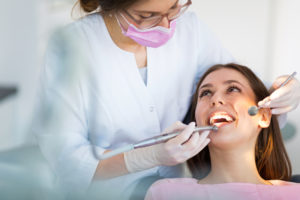
How Can a Dentist Help You?
A dentist is a professional that every person needs. Dentists are vital to you having good oral health for life. They can detect the presence of tooth decay, gum disease, oral cancer, oral sores and any other oral problem, plus they do the work to help correct those issues. These professionals go to school for 10 years just learning about your mouth and facial structures so they can help you stay healthy. Orthodontists receive all that same training, plus 2-3 extra years learning about straightening teeth, bite and alignment issues and structural problems with the mouth.
Because these professionals do different work, you will probably need both. Dentists have the primary duty to find the presence of tooth decay (cavities) using digital and x-ray technology. Then they have many different procedures to remove decay, fill the cavity, and restore your smile. They can do cosmetic work to make your smile look better and they deal primarily with oral health diseases and helping you avoid them so you don’t have early tooth loss. Orthodontists are trained to see cavities and oral health issues, but they will do structural work to help change your smile instead of dealing with the disease aspect of your oral health. Their work focuses on prevention of those issues in the first place.
How Can an Orthodontist Help You?
Did you know that people have had orthodontic care at least since the time of the Ancient Egyptians? More discoveries are finding orthodontic appliances on teeth thousands of years ago. Why? Because people that long ago also understood the benefits of straighter teeth. It took many centuries for orthodontists and orthodontic work to become established.
Studies found that straighter teeth made dental issues less likely to happen. When patients received orthodontic straightening—even through crude methods—they were less likely to have their teeth decay or break and less likely to have gum issues. The same holds true today. Crooked teeth are teeth that are much harder to clean. In a straight, even bite, the top front teeth rest just slightly in front of the bottom front teeth. From the front to the back, the teeth rest evenly on one another, evening out pressure from biting, chewing, eating, talking and more.
When the teeth are crooked, patients will get areas where they simply can’t get a toothbrush or floss to and those areas decay. The teeth may be at odd angles, and with uneven pressure placed on those teeth all the time, they may simply break. If you have crooked teeth, an orthodontist can easily make a plan to straighten them. Using digital x-rays, an orthodontist can examine your bite, alignment and incoming teeth and can make a plan to ensure all your teeth line up for the best oral health you could have.
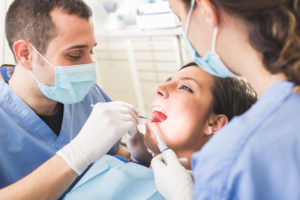
Do You Need an Orthodontist?
Not everyone will need an orthodontist, but their care can benefit most people. Even getting slight straightening of the teeth can reduce your dental breaks, emergencies and issues with oral health diseases. Orthodontic care can even help with bad breath if that stems from plaque and bacteria in the mouth that you can’t quite get rid of. To know for sure if you need an orthodontist, make sure to schedule an examination.
For children, the national recommendation by groups such as the American Association of Orthodontics is to visit an orthodontist around age 7 or 8. This is a key time for an orthodontist to be able to tell if the incoming adult teeth are coming in at the correct angle and place in the mouth. Oral health issues that can become severe later on in life can be caught early and childhood and many oral problems can be prevented with some orthodontic care. For all other issues with finding and filling cavities, gum disease, sores and more, make sure to call your dentist. To schedule your consultation with the orthodontist, call Belmar Orthodontics today at (303) 225-9016!
Braces Can Change Your Life
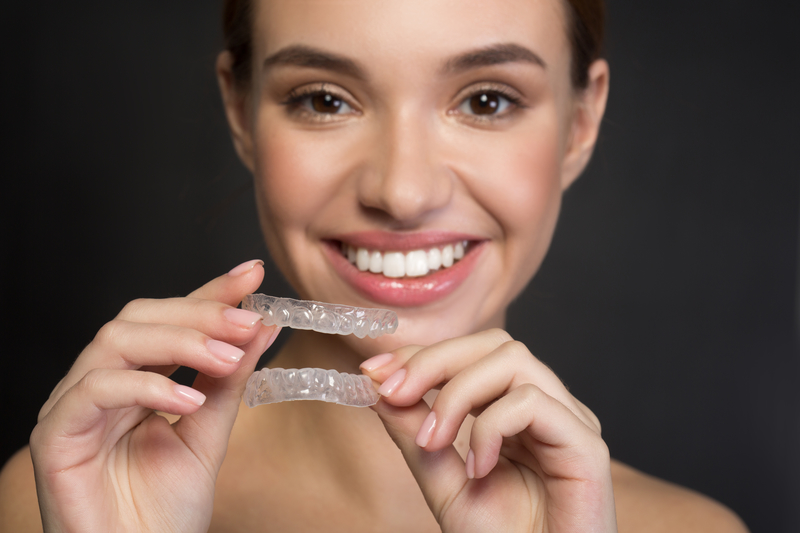
Your oral health can determine much of your overall health. Food and substances enter through your mouth, affecting your waistline, your appearance and your health. Your oral health can improve your overall health when you make changes in oral hygiene and bite and alignment. Misalignments in bites and crooked teeth can cause health and social problems, as they can lead to speech impediments, oral health diseases, and worsening chronic conditions. With braces, you can not only change how healthy your mouth is, but can change your life too!
Growing In Straight Teeth
Many people picture teens when they think of braces. However, 1/4th of people with braces are kids. Child orthodontics help straighten out teeth that would cause them speech problems, broken teeth and trouble growing in the permanent teeth. Adults and teens usually get them for crooked teeth.
However, braces aren’t just for people with crooked teeth. You may see patients young and old that appear to have a straight smile and yet they have to get braces. In this case, there is probably an oral health issue with the bite or alignment. Your teeth should line up along both the upper jaw and the lower jaw. When you go to the dentist, they will ask you to bite together so that they can view how your bite rests. How your teeth sit when they are resting together can determine if you will have dental issues and even speech impediments. This is especially true for young kids who are losing baby teeth and having adult teeth grow in.
Children have their baby teeth for years—even up to age 12 or later at times. Those baby teeth start to space out a bit more as a child grows from an infant to a school-aged child. Their mouth grows with them, making room for adult teeth. 20 baby teeth will become 32 adult teeth (including the wisdom teeth). However, those teeth don’t always come into the mouth in the right position or the right direction. With a healthy bite, the upper and lower jaws should have the teeth lining up evenly with one another. The teeth should be straight up and down, and the front upper teeth will rest just slightly in front of the bottom front teeth.
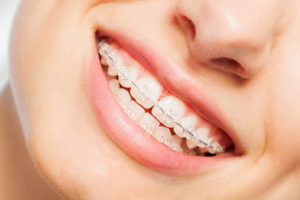
Braces Can Prevent Dental Injuries
When teeth aren’t straight and they jut out at different angles, it can mean broken, cracked or chipped teeth in the future. Those dental injuries would be caused by uneven pressure on certain teeth which will eventually break them or will cause areas of decay that you can’t clean well. The alignment of the teeth can also cause speech impediments when forming words, and those impediments can last for life if bite, alignment and crooked teeth aren’t corrected. For young children and adults alike, receiving braces for these issues can certainly change not only their oral health, but their life.
Braces are sometimes needed to make space in a patient’s mouth. Not all mouths grow to fit the incoming teeth, but that doesn’t mean the adult teeth won’t stop coming in. All your teeth will come in, even if they have to crowd out other teeth. That crowding can be painful and even one tooth coming in where there isn’t room can cause all of your teeth to go crooked. As a tooth comes in, it will slowly push other teeth from the area, which then have to shift. This is what wisdom teeth commonly do, and it can be painful as it messes up a smile. Braces can stop that from happening by making plenty of space in the mouth for teeth that are still coming in.
What If You Have Your Teeth Already?
The dental issues we have mentioned will generally happen before a person has reached adulthood. The American Association of Orthodontics recommends that children have their first orthodontic appointment around age 7 or 8. This is when we can see how the baby teeth are falling out and how the permanent teeth are coming in. We stop dental issues before they start forming, and during this time when the jaw bones are still soft enough to mold. However, at least 1/4th of patients that have braces get them when they are adults. The jaws have grow completely and have hardened into place by adulthood, making orthodontic treatment harder.
However, we said “harder”, not “impossible”. Orthodontic advancements can definitely help an adult change their smile to change their life. Now, more than ever, it is becoming increasingly important to have a straight smile as an adult. Studies show that others make an opinion of you based off of the first few seconds of meeting you. Your appearance can go a long way. Your smile is also one of the top 3 features others will notice first when formulating an opinion about you. Studies show that those with straighter teeth are seen as more attractive, successful, smart, healthy and trustworthy. Employers are more likely to hire those with straight smiles over those who don’t have them.

Your Options
If you’re an adult, you can straighten your smile without it being noticeable. Children often go the route of traditional metal braces or ceramic braces, which are the same but made from ceramic material. Adults and many teens opt for hidden options like lingual braces or Invisalign treatment. Lingual braces are metal braces that attach behind the teeth, staying hidden as they correct bite, alignment and your teeth. Invisalign treatment consists of transparent aligners patients change out every week. However, they don’t do as well with larger bite and alignment issues. It’s never too late to receive orthodontic treatment.
Whether you are young or old, you can change your smile to reduce or eliminate your problems with speech, tooth decay, oral health issues, dental injuries and to even feel more attractive. Want to see just how much braces can change your life? Call Belmar Orthodontics today at (303) 225-9016 to receive your free consultation!
Preventing Cavities During Braces
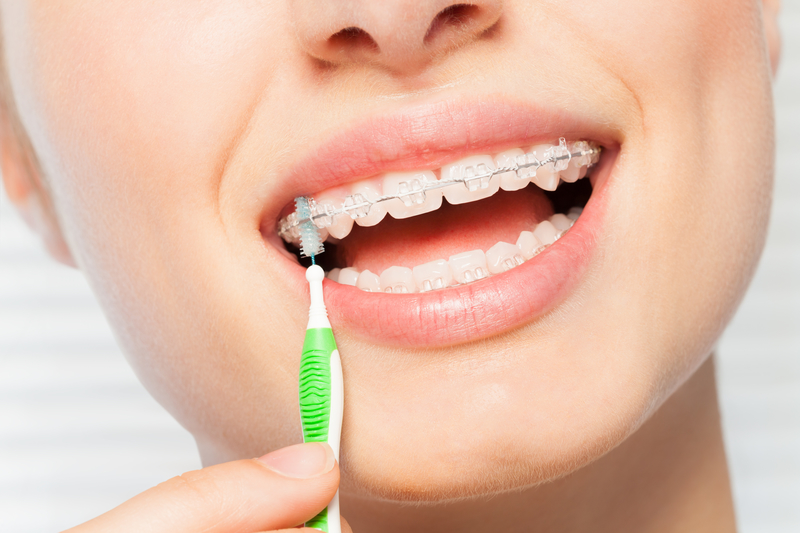
Braces is an exciting time for getting that straight smile you’ve always wanted. The not-so-exciting part about braces though, is that they give you a greater risk for cavities. Because there are appliances attached to your teeth, they can become havens for bacteria and plaque buildup. Proper oral hygiene, avoiding certain foods can help you prevent cavities during your time with braces!
Your First Orthodontic Appointment
Finding cavities before you get braces is key to ensuring that you have a healthy smile before getting brackets and wires on your teeth. With braces, you will meet often with your orthodontist to have your braces adjusted. However, you still need to go to your dental appointments to make sure you don’t have cavities during braces.
Traditional metal braces, ceramic braces and lingual braces all have brackets and wires that go on your teeth. Before you get fitted for these braces, you will have dental x-rays taken by the dentist to detect cavities. It’s very important to get your exam so tooth decay is detected. Otherwise, you could end up with large cavities during braces. If cavities are found, they must be fixed before we put your braces on.
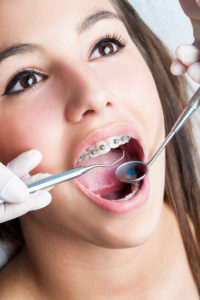
Oral Hygiene Is a Must
The status of your smile and your oral health will depend on what you do once you get your braces. The American Dental Association recommends brushing your teeth at least twice a day and flossing 1-2 times. That recommendation is for patients who don’t have braces. When you have braces, you have to be extra meticulous with oral hygiene practices and you will have to do them more than you used to. That means, brushing after every single meal if you can.
To avoid cavities during braces:
- Brush your teeth after every meal. Use a soft-bristled toothbrush with fluoride toothpaste, and brush for 2 minutes every time, making sure to go in all different directions to dislodge food.
- Floss your teeth. This is a habit many people skip with braces because it takes a bit more time. However, it’s time well spent. Floss at least twice a day, using threadable floss. This kind of floss allows you to thread it through the spaces between your teeth, pulling it through so you can floss like normal. It makes flossing a breeze and helps prevent cavities during braces.
- Use orthodontic cleaning tools. A waterpik is a great water-spraying tool that can help you dislodge stuck food. A braces brush (that looks like a Christmas tree brush) can get food out of brackets.
- Watch what you eat! More sugar means more cavities during braces. Limit how much sugar you eat. You want to avoid sticky, sugary foods such as taffy, Starbursts, dried fruit, gummies, fruit snacks, caramels, and anything similar.
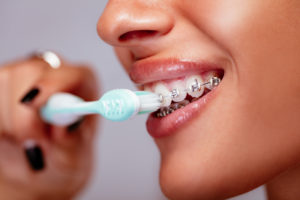
Developing Cavities During Braces
Sometimes, tooth enamel is simply weak and tooth decay happens, despite all your hard effort to avoid cavities. When you eat, sugars in your food mixes with mouth bacteria to create plaque. That plaque sticks to your teeth and slowly eats it away, creating decay. You only need plaque stuck in the right place to develop cavities during braces. When you have hidden tooth decay, you may start to feel symptoms such as a toothache, tooth sensitivity or pains with hot and cold. When you see these signs, get dental x-rays taken to see if you have cavities during braces.
If there is a cavity, you actually can have it fixed even if you have braces. It all depends on where the decay is. In most cases, cavities during braces can be fixed because many will lie on surfaces not covered with brackets or wires. You would have the decay drilled out and filled as you normally would. However, if you have a band on your teeth or brackets and wires right where decay is, we would have to remove the bracket or wire while you get it fixed at the dental office. We would then have you come back to our office to get your dental appliance reattached. Patients can sometimes develop such severe cavities during braces that they will need root canals. However, if you are taking care of your teeth, you won’t ever have to worry about that.
Best Option to Avoid Cavities
If you are worried about cavities during braces or have seen a family member get cavities during braces, then getting braces might make you nervous. However, no matter what braces option you choose, the benefits of a straight, beautiful smile can last a lifetime. It’s definitely worth it to get braces; you will just have to be careful to take care of them. If cavities during braces are a concern, consider the benefits of using Invisalign aligners. This is one of our most popular orthodontic options for teens and adults because it is a hidden option for straightening your teeth.
Invisalign transparent aligners are a series of custom-made aligners (like retainers) that fit incredibly snug to your teeth. We take digital calculations of your mouth, where we then design transparent aligners around the shape of your teeth and where we want them to be 18-24 months from that time. Each week, you will switch to a new aligner, which will slowly put pressure on different areas of your mouth, shaping the teeth into a straight line. The aligners are clear and designed to be virtually unnoticeable on your teeth.
When it comes to cavities during braces, you are the one that decides if you will get them with this orthodontic option. That’s because that are completely removable for eating, drinking, flossing and brushing your teeth. It takes less time to brush and floss because of this and there are no appliances on your teeth. This can reduce your risk for cavities during braces, especially if you already know that you have weak tooth enamel. For any questions about cavities during braces, call Belmar Orthodontics at (303) 225-9016!
Be Vigilant with Your Child’s Oral Health
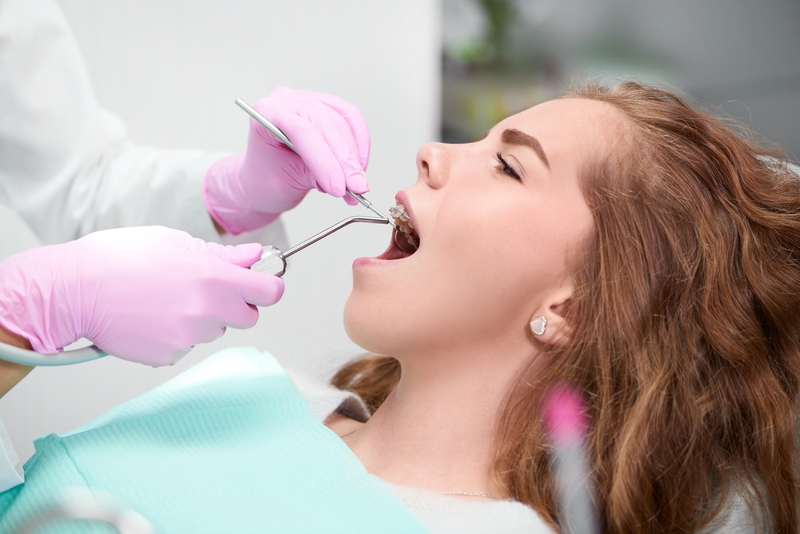
More than half the people that wear braces are children and teens. This can be an exciting time for kids to fix bite problems and crooked teeth. However, tooth decay and oral health problems also run rampant during braces if oral hygiene guidelines aren’t followed. Sometimes children and teens need a nudge to help them with their oral health. Find out what they should be doing to care for their braces during this time!
Facts About Braces
Did you know that there are over 4 million people in the United States each year that wear braces? About 1/4th of those are adults and the rest are children and teens. Patients use braces as teens to straighten the adult, permanent teeth that have come in. When children have child orthodontics, those brackets and wires are meant to correct bite and alignment issues that could cause a child severe problems in the future. Children can then straighten their permanent teeth later on.
There are common oral health problems that many children face today. It’s called tooth decay, and the National Institutes of Health reports that it’s the most “prevalent, chronic disease” among children and adults. 42% of children will have tooth decay before they are 12. 23% of those will have untreated dental decay. About 92% of adults have had tooth decay sometime in their life. The worst part about this is that tooth decay is completely preventable if a child, teen or adult has good oral health through practicing proper oral hygiene.
It may take several years for a child to have the right dexterity in their hands to brush and floss correctly. That is why parents must take care of their child’s oral health when they are young, or it could lead to serious problems. Children rely on parents to help their mouth stay healthy. Even teens need to be told to brush and floss, as it’s something they often forget. These habits are especially important during braces, as oral health is most affected when there are brackets and wires on the teeth.

Helping Your Child’s Oral Health
The American Academy of Pediatrics recommends that children see a dentist around 1 year or within 6 months of their first tooth coming in. After that, they should go biannually to the dentist. This is how a dentist can start to see signs of bite and alignment problems, which are then referred to an orthodontist.
With some orthodontic appointments, a child can be fitted for braces to correct problems that are easy to fix with a young, moldable jaw, but hard to fix when a person is older and their jaws are set. Without braces, you will have to help your child brush and floss their teeth at least twice a day as the American Dental Association recommends. Use child toothpaste enhanced with decay-fighting fluoride and a toothbrush that fits the size of your child’s mouth.
Children will need to floss between their teeth, but might have to start out with flossers for kids. With braces, children should be brushing at least twice a day, but after every meal is even better. They should brush at 45-degree angles, making sure to move in all different directions to dislodge food that has been stuck in the braces. Flossing is incredibly important as well, as it gets 40% of tooth surfaces that are missed if flossing is skipped. Help them learn how to use threadable floss. This gets poked through the spaces between their teeth, pulled through, and flossed like you would normally do. Use a Christmas tree brush or a waterpik to help them dislodge stuck food.
Do You Have Good Habits?
One of the best ways to help your child with their oral health is to show them its importance through your own actions. If you don’t brush and floss your teeth, your child or teen may not either. When you’re also not visiting the dentist, odds are that your child isn’t either. If you eat a poor diet full of sugar, then your child will do the same. Children often copy what their parents do.
Make sure you are brushing your teeth at least twice a day, especially when your children can see you. Floss your teeth and teach them how to floss properly as well. When you need to go to the dentist, take your children with you and have them get their comprehensive exams and cleanings. All these oral health measures will ensure their mouths stay clean and healthy for years!
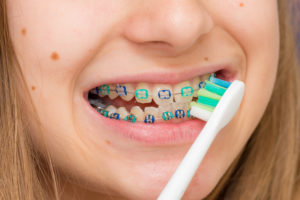
Other Factors to Consider
Your child can brush and floss their teeth often and may still end up with cavities. Cavities come from plaque in the mouth that has set on the teeth for too long. Your mouth makes plaque when you eat sugary foods and that sugar mixes with mouth bacteria to make acidic plaque. That acid is what causes the tooth decay. However, if you limit your sugar intake to begin with, you won’t have the problem with tooth decay.
Unfortunately, sugar is one of the most-consumed substances in the world. It is literally found in almost every food. That is why tooth decay is so common, especially in children. Limit your child’s sugar intake if you want them to have healthy teeth when their braces come off. Teeth that don’t get brushed or flossed often with braces, may end up having cavities, gum disease and eroded areas of their teeth when braces come off.
Their food can also leave them with squares on their teeth from the brackets, because the surrounding tooth has been damaged by food. Make sure to consider what your child is putting in their mouth if you want to help them have good oral health! For more tips or answers to questions about your child’s braces, call Belmar Orthodontics today at (303) 225-9016!
Tips for Success and Happiness with Your Braces
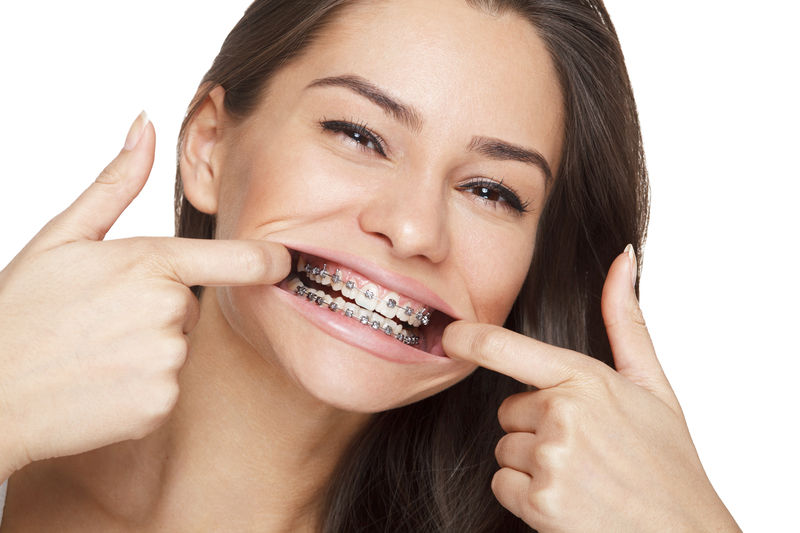
Many adults and teens feel like they will look childish with braces on. However, that still doesn’t stop more than 4 million people wearing braces each year in the U.S. Yes, braces are harder to clean and require more care. However, that care only takes a few extra minutes each day, and you have orthodontic options that can make you extremely happy with your braces. Find out how you benefit from orthodontics!
Your First Week with Braces
When you first get brackets and wires on your teeth, you will have tooth sensitivity for a few days. That sensitivity and soreness will wear off, but during that time, stick to soft foods such as pasta, yogurt, mashed potatoes, etc. Over-the-counter painkillers (like acetaminophen) can help curb pain that first week and at each braces adjustment.
Your braces will feel bulky in your mouth at first, but will quickly start to feel normal. Even though there are changes with braces, you can be successful with your treatment if you do everything the orthodontist tells you. This includes using your bands like they tell you, having good oral health and avoiding foods that can cause you trouble.
There are foods you want to avoid that will either break your brackets or wires or that will become stuck in them. Many foods on this list are also full of sugar, which is what makes plaque that coats your teeth. When plaque sits on the teeth, it decays them and erodes them. Avoid foods like:
- Hard candies
- Chewing on ice
- Apples, carrots, and hard fruits and veggies
- Popcorn (because of kernels), nuts and chunky peanut butter
- Chips and hard snacks
- Caramels, licorice, taffy, Tootsie Rolls, Starbursts, Sugar Daddies, Skittles and similar candies
- Corn on the cob
- Dried fruit, fruit snacks and gummies (which get stuck in brackets and teeth)
- Gum

Taking Care of Your Teeth
Caring for your teeth through proper oral hygiene is essential if you want to love your braces and if you want your teeth to be in good shape when they come off. Patients who skip brushing and flossing will end up with tooth decay, tooth erosion (worn away areas of the teeth) and stains on their teeth when the braces come off. Don’t let that be you! Follow these tips for taking care of your braces successfully:
- Brush, brush, brush! Aim for three times a day instead of just the recommended two times. The American Dental Association recommends that patients brush for at least 2 minutes every time, at least morning and night. Choose a soft-bristled toothbrush that will be more gentle on your teeth and switch out your brush every 3 months.
- Floss your teeth. Flossing is the thing that is most often skipped, especially by children and teens. However, flossing gets about 40% of your tooth surfaces that brushing misses. It is one of the only ways to dislodge stuck food that will decay your teeth. Floss 1-2 times a day. However, invest in flossers or threadable floss, which you can pull through the cracks in your teeth, getting under the wires. This makes flossing so much easier.
- Use a Waterpik and brush. Patients often get food stuck in their teeth that flossing and brushing can’t get out. A waterpik is a small device that shoots water. You shoot the water where you want to dislodge the food or particles in brackets or in between the teeth. A braces brush looks like a tiny Christmas tree. It can get all the gunk out of your brackets and wires with ease.
- Don’t chew on non-food items! Pencils, fingernails, and any other hard item can break your braces.
Benefits that Braces Can Give You
Some patients love their braces, while others don’t. If you are the latter, just remember why you are getting braces: you are looking forward to that beautiful, straight smile. You only have braces on for 1-2 years. If you get through that time, you get to have a straight, beautiful smile for life. Studies show that your smile goes a long way as well. It’s one of the first things others notice about you. In studies done about straight teeth vs. crooked teeth, the impressions others got were quite impressive:
- Invisalign (Align Technology) found that people with straight teeth were 45% more likely to be hired for a job.
- They were seen as 58% more likely to be wealthy and successful.
- People perceived people with straight teeth as healthier, happier, and even smarter than others.
- A whopping 73% of people were more likely to trust someone with straight teeth as well!
Whether you love your braces or not, just remember the amazing benefits that come from having a straight smile. It will not only improve your social life, but straighter teeth are easier to clean and less prone to tooth decay and oral health diseases as well.

Being Happy with Your Braces
The best way to be happy about your braces is to choose braces that you love. Some patients prefer metal braces because they are the most economical choice, while others like Invisalign because they are removable. Patients also enjoy clear, ceramic braces that are like traditional braces, but made from white, ceramic material. If you want the sturdiness of metal braces, but want them hidden like Invisalign, you can also choose our lingual braces option.
These are braces hidden behind the teeth. If you are self-conscious about your appearance and want to straighten your smile quickly, this may be the option you want. No matter what you choose, remember that this is your only time with braces! Enjoy going through this journey and even get your braces at the same time as your friends to make it more fun. For tips about adjustments, appointments and any extra tips for your braces, call Belmar Orthodontics today at (303) 225-9016!
Teaching Children Good Oral Hygiene Habits

If you teach a child good oral hygiene habits early on, odds are that they will have better oral hygiene habits when they are teens and adults. As soon as a toddler gets their first tooth, it’s essential to start brushing and flossing their teeth. Afterwards, you will need to teach them the basics of good oral hygiene practices, especially when it comes to wearing braces. Find out what those basics are and what you should be thinking about for your child’s oral health!
Teaching Good Oral Hygiene Early
Good oral hygiene habits are essential for a healthy mouth and especially during orthodontic care. Many children need early orthodontics, which is also known as “child orthodontics”. This is when bite and alignment issues are corrected around age 7 or 8 to avoid serious problems later on. However, we hope that every child has good oral hygiene habits established well before this visit. Otherwise, not only will a child be dealing with bite and alignment issues, but they will also be dealing with tooth decay.
As soon as your child gets their first tooth as a baby, you need to start brushing that tooth. Brush it morning and night with a rice-size amount of fluoride toothpaste. Also make sure to clean your baby’s gums with a wet cloth after feedings. Once they start to grow, begin teaching them how to brush their teeth properly. You will have to help brush your child’s teeth for the first couple of years until they have the dexterity in their hands to do it themselves. Flossing will come later as more teeth come in.

Learning to Brush
Brushing the teeth is one of the most important habits a child can have. Brushing long enough is key for a healthy mouth. Make sure you get a toothbrush that fits the size of your child’s mouth. There are brushes for infants, toddlers, children, teens and adults. All will be different sizes and some children brushes will come in fun shapes and colors to help children brush.
Children can’t always tell how long they have been brushing. Having them brush their teeth for a duration of a song or brushing your teeth alongside them to make sure they brush long enough. When they are old enough to have braces, brushing is even more important than before to avoid tooth decay. Food that gets stuck in brackets can cause rapid decay. Make sure they brush longer and at different angles to dislodge food. When children are first learning, brush with them as many days as it takes when first learning to brush their teeth. Do the same when they learn to brush with braces.
Flossing 101
Children won’t have to floss until they are toddlers. The baby teeth are spaced out until they all come in. Kids will have a total of 20 baby teeth that will start to come closer together as a baby ages. Until a child has the dexterity to use floss like an adult, it’s smart to invest in flossers. These are secure, hand-held flossing tools that children can put in between their teeth to easily dislodge food. Ask us about mouthwash and fluoride products to see if they should be part of your child’s oral hygiene routine as well.
See a Dentist and Orthodontist
Starting from an early age, children need to start visiting the dentist. By age 7, they should see us for an orthodontic exam as well. Dental visits themselves are so important that most dental insurances cover those twice-a-year visits. These biannual visits generally consist of comprehensive exams and dental cleanings. At first, children may be nervous about visiting a dentist. Offices can be large with busy equipment that children aren’t familiar with. Dental tools can also be loud, which can make children nervous. However, these visits are nothing to worry about whether it is a dentist or orthodontist.
To help your child get used to being in an office, make sure you go to a pediatric dentist instead of a general dentist while they are young. Pediatric offices (such as our orthodontic one) has staff that is trained to work well with children. Dr. Hardyl has experience with children on a daily basis. He was trained in both dentistry and orthodontics and can spot the signs of dental issues early-on. His staff knows what kids worry about and they know how to explain dental and orthodontic terms so a child can understand. An exam sounds serious, but it’s really just Dr. Hardy looking inside your child’s mouth for any bite, alignment or dental problems. If a child hasn’t seen Dr. Hardy by age 7, make sure to get them in for an examination!
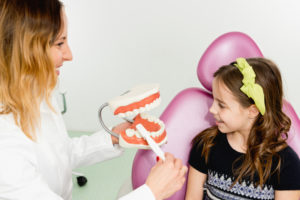
Good Habits for Life
Start children out young when teaching them good oral hygiene. If you make a habit of brushing and flossing, children will see that example and will follow it. When you help them learn good oral hygiene habits as soon as they can talk and understand, they can start keeping their mouth clean themselves. There are many resources online to help teach children specifics of brushing, flossing, and for learning about dental hygiene. We help children every day with brushing, flossing, caring for braces and establishing good oral hygiene. Call Belmar Orthodontics at (303) 225-9016 with any and all questions you have about your child’s oral health. Let us help you as you and your child learn to establish good oral hygiene habits together!
Invisalign Treatment for You and Your Child
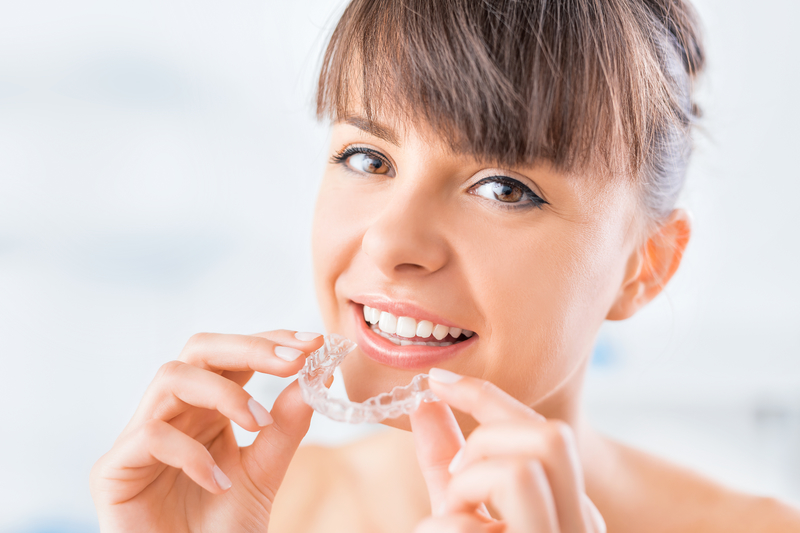
Many people think of traditional metal brackets when they picture braces in their mind. However, these are not the only type of braces available to patients. Lingual braces and ceramic braces also exist, but one of our favorite options is Invisalign treatment. Named for the invisible aligners that help shift your teeth, Invisalign is the perfect treatment option for adults and teens who want to straighten their teeth more discreetly. Find out how these aligners are custom-designed for each patient, what your treatment will look like and how you can benefit from choosing Invisalign!
What Is Invisalign?
In the past, metal braces were the only option people had to straighten their teeth. Decades ago, these metal braces even came with large headgear and lengthy treatment. Technology continues to advance each year, and now you have better (and much more discreet) options for straightening your teeth. Invisalign is one such option for patients who want straight teeth, but don’t want metal brackets for 18-24 months to achieve that smile. Invisalign is the same type of treatment, but instead of brackets, you get transparent aligners that go in your mouth much like retainers. Advantages of this orthodontic option include:
- Virtual invisibility because the aligners are transparent.
- You can remove the aligners whenever you need to, especially for eating, drinking, brushing and flossing.
- Cleaning the aligners are much easier than cleaning brackets and wires.
- Less office visits are typically needed for patients.
- Total time for optimal results is generally shorter than metal braces.
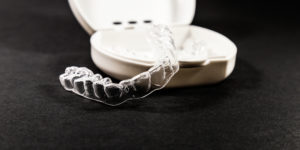
How Does It Work?
Your Invisalign treatment will be much different than traditional metal braces would be. However, Invisalign treatment is much easier than metal braces. Dr. Hardy will take an impression of your teeth using a special 3D imaging machine called an iTero Element Scanner. This will digitally record all the grooves and shapes of your current teeth without any sticky molds. Then, your aligners will be custom-made for you that you will take home with you and switch out every 2-3 weeks. Every person’s gumline is different, so the digital impressions of your teeth is an important part of the Invisalign creation process. Once your aligners are made, we trim them to fit your gum line. A custom-fit means that your aligners will fit so snug against your teeth that they will almost seem invisible.
Your treatment plan will be made based off of the current shape of your teeth and if you have any bite and alignment issues. We will be able to tell if any of these issues are present during your consultation. Once your treatment plan is made, you will wear your aligners between 20-22 hours a day for 18-24 months. The treatment time is similar to what metal braces or other orthodontic options would be. On average, our patients need 18-30 aligners for a period of 9-15 months to achieve their desired outcome.
Can Children Use Invisalign?
Some children will be candidates for Invisalign treatment, whereas others will not be. Often, child orthodontics is needed to correct bite and alignment problems that are severe in children. These problems include overbite, underbite, crossbite and other problems with a misaligned bite and jaw. Some problems are severe enough that children will require metal or ceramic braces to fix the problem. Invisalign treatment can correct some bite and alignment issues, but not if they are severe. A severe problem may make your child unable to use Invisalign aligners until they receive orthodontic treatment for teeth straightening as a teenager.
There is also the problem of the aligners being removable. Since they are clear, they are easily lost, which parents don’t want. If your child is fairly young, metal braces might be the smartest choice for them so they don’t lose the aligners. Dr. Hardy can assess your child’s oral health to see if they are candidates for Invisalign treatment or if they need other orthodontic appliances.
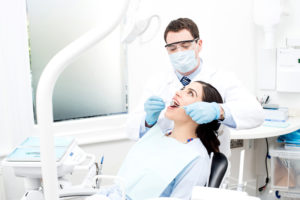
Invisalign Teen
For many teens, they don’t want metal braces that are very visible to everyone. Metal appliances can also make eating, speaking and maintaining clean teeth challenging. Many teenagers are also self-conscious about braces and their appearance, which generally brings less smiles and confidence. The invisibility of Invisalign Teen is why it’s so popular with this age group. Invisalign Teen is simply Invisalign treatment made with teenagers in mind. For teens who play sports, they can remove their aligners in order to wear mouth guards or to play musical instruments.
Why Should I Choose Invisalign?
Do you want straighter teeth? Do you want to straighten your teeth without everyone knowing? Would you like to avoid all the work that goes into cleaning brackets with metal braces? Then Invisalign treatment is for you! Invisalign aligners are fit to your mouth, comfortable and transparent. You can remove them as you need to and cleaning is very easy, especially for children and teens. If you want a beautiful smile while you receive orthodontic treatment, ask our office about receiving Invisalign treatment for you and your child. Call Belmar Orthodontics today at (303) 225-9016 for your free consultation!
Dentistry and Orthodontics Are Closely Related

Dentistry and orthodontics are quite different, but they are also closely related. You need care from both a dentist and an orthodontist in order to keep your smile healthy. Dentistry and orthodontics both deal with the health of your smile. One focuses on straightening the smile and other focuses on tooth decay, gum disease and treatments to help correct oral issues. Both involve services that “fix” problems with the teeth to help make your mouth healthier, thus making you healthier. Find out the difference between dentistry and orthodontics, the similarities, and how both can help you have the best smile possible.
What Dentists Do
Dentists go to school to specialize in problems involving the teeth, nerves, gums and jaw. They can provide any or all of the following services:
- Comprehensive exams and dental cleanings
- Oral cancer screenings
- Sedation dentistry
- Laser cavity detection and cavity detection using x-ray imaging
- Tooth extractions
- Laser tissue treatment
- Oral hygiene training
- Dental sealants
- Periodontal treatments on the gums
- Scaling and root planing for gum disease
Dentists are also trained in cosmetic dentistry and can provide services such as dental implants, porcelain veneers, porcelain crowns, cosmetic bonding, dental bridges and even botox treatment. Restorative dentistry involves root canals and root canal therapy, teeth-whitening services, tooth-colored fillings, and in some cases orthodontic care through Invisalign. The dentist is usually trained in orthodontics to provide this service. If a dentist finds that a patient has a problem with their bite or alignment, they will refer the patient to an orthodontist who is certified and trained to correct the issue.
What Orthodontists Do
Orthodontists must obtain several degrees to become orthodontists. They need more training than dentists do because they must be able to correct smiles as well as identify oral health issues. Orthodontists are specially trained with correcting bites, occlusion (or alignment), and in straightening the teeth. In a healthy mouth, the upper jaw rests on top of the lower jaw. The upper front teeth will rest slightly forward on top of the lower front teeth. Not all mouths are aligned correctly. Some bites that orthodontists correct include:
- Overbite – In the upper jaw, the front teeth rest over the lower front teeth instead of above. You never want the front teeth to overlap the bottom teeth completely, as this creates pain and other problems when biting, eating, and other everyday tasks.
- Underbite – This is the opposite of overbite. The lower front teeth rest far in front of the upper front teeth. This creates similar jaw problems as mentioned with overbite. Underbite can lead to jaw and joint pain, earaches, headaches. and more.
- Crossbite – Crossbite involves teeth that cross in all different directions. Some of the teeth are slanted toward the tongue. Other teeth are slanted towards the cheeks. This creates uneven pressure all over the mouth when biting and chewing, which can lead to broken or fractured teeth, weakened enamel, pain, and more. Crossbite can even cause abnormal facial development and jaw problems if left untreated.
- Openbite – Openbite refers to an opening (or gap) in the teeth between the upper and lower jaws when the mouth is closed. This gap is right at the front of the teeth and might even appear as a hole in a patient’s smile. Openbite leads to speech impediments, lisps and other problems with speaking if left untreated.
Dentistry and Orthodontics Compared
Did you know that an orthodontist has dental training? Orthodontists must obtain several degrees in order to work. They must obtain a Doctor of Dental Surgery (DDS) degree or a Doctor of Medical Dentistry (DMD) degree just as dentists do. Then, they must apply to an orthodontic graduate program to obtain a Masters of Science degree. Orthodontists go through all the same training as dentists and then some. This is how orthodontists can spot dental issues forming. Basically, all orthodontists are dentists but not all dentists are orthodontists.
If you have problems with your teeth, gums, oral nerves or jaw, then go see your dentist. Your dentist will refer you to an orthodontist if the issue is corrected by an orthodontist or has to do with bite, alignment or straightening. When it comes to problems such as tooth decay (cavities), both dentists and orthodontists can help you in some way. Orthodontic care via braces can help straighten the teeth, thus making them easier to clean and reducing your risk for tooth decay. Dentists can also help you prevent tooth decay with comprehensive exams, biannual cleanings and treatments that stop the progression of cavities if they have formed.
Benefit From Both
Both dentistry and orthodontics involve services that “fix” problems with the teeth to help make your mouth healthier, thus making you healthier. Both professions involve doctors who are highly trained to help problems with your oral health. Patients can benefit greatly from having both a dentist and an orthodontist. Take a step towards a healthier mouth, and schedule an appointment with Dr. Hardy today by calling Belmar Orthodontics at (303) 225-9016!
How Braces Improve Dental Health
Did you know that braces can improve your dental health? Dental and orthodontic care go hand-in-hand. Many dentists have training to spot problems with bite and alignment. These problems can be corrected with proper orthodontic care, and should be corrected early-on before children have grown. Receiving braces as a child can correct problems that become severe later in life. Receiving braces as an adolescent and even as an adult can greatly improve your oral health, as it decreases your chances for tooth decay and even gum disease. Straighter teeth are teeth that are easier to clean and easier to take care of. Learn how investing in braces can improve your dental health today!
Braces Improve Dental Health
DId you know that orthodontists also attend dental school? Orthodontists go through 4 years of undergraduate school, then move on to 4 years of dental school. Afterwards, they must complete and additional 2-3 years of special training to perform orthodontics. Orthodontists are skilled at not only making your teeth straighter, but also helping you to improve your dental health. Dr. Hardy understands how the teeth work and that straighter teeth are teeth that have a reduced risk for cavities and problems with gum disease.
When the teeth are crooked, it can make it much harder to clean between each tooth thoroughly each day. To keep a healthy mouth, every single day counts and plaque must be removed with frequent brushing and flossing. What if the crookedness of the teeth prevent your toothbrush or floss from reaching certain areas? Those areas will be prone to, and will probably start to develop, tooth decay and/or problems with the gums. In contrast, when the teeth have been properly aligned with orthodontic care, cleaning them becomes a simple task. A toothbrush can easily reach all the surfaces and floss can get in between each tooth. That gives you a much better chance at having great oral health.
What Else Can Braces Do?
Braces are highly beneficial for not only straightening your pearly whites, but also for correcting bite and alignment problems that so many children have. Between the ages of 7 and 8, a child should see an orthodontist and get their bite assessed. We look to see if your bite and teeth line up correctly. If they don’t, you may have one of the following: openbite, crossbite, overbite, underbite, malocclusion, etc. All of these problems can make chewing, speaking, biting, etc., difficult. If a smile is left untreated, problems that were minor become severe over time and require more extensive procedures. However, braces are a perfect method for fixing these problems at an early age, saving you time, money and your health.
Common Oral Health Problems
We mentioned that braces can help your dental health by lowering your risk for oral health issues. The two most common oral health problems are tooth decay and gum disease. You may know tooth decay by one of its other names: dental caries or cavities. Tooth decay is the erosion of the tooth enamel over time. Almost every patient has had some form of tooth decay in their life. However, tooth decay–or cavities–are 100% preventable if you have a habit of taking care of your teeth.
Tooth decay is caused by plaque—a sticky film made from sugars in the foods you eat mixed with bacteria. This plaque sits on the teeth and erodes the tooth enamel. Over time, that plaque can eventually weaken a tooth and get inside, where it will start to cause decay. The teeth aren’t the only ones that are affected by plaque. Plaque also attacks the gums, causing them to become swollen, red, and irritated. You may even see your gums bleed easier. When the gums continue to become inflamed, they will eventually recede from the teeth, causing the teeth to fall out. Thankfully, both tooth decay and gum disease are avoidable. Straighter teeth can help make brushing easier, and thus help decrease your chances for either condition.
Your Dental Health
When it comes to the teeth, you only have one set. You want to do all you can to keep your dental health intact. Straightening your teeth with braces can help you, plus, you’ll receive all the benefits a better smile can give you. So what are you waiting for? Schedule your appointment with Belmar Orthodontics today at (303) 225-9016!

